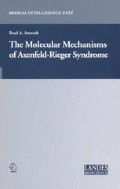Summary
The anomalies in most of the involved tissues in Rieger syndrome (anterior segment of the eye, cranial bones, teeth, periumbilical skin) are derived from the neural crest. If PAX6 expression in the neuroectoderm includes the neural crest, most of the Rieger-anomalies could be explained by a PAX6 deletion. However, little is known about the behavior of cells within the human anterior neural tube and the molecular action of PAX6 has not been determined.
Access this chapter
Tax calculation will be finalised at checkout
Purchases are for personal use only
Preview
Unable to display preview. Download preview PDF.
References
Amendt BA, Semina EV, Alward WLM. Rieger syndrome: A clinical, molecular, and biochemical analysis. Cell Mol Life Sci 2000; 57:1652–1666.
Brændstrup JM. Posterior embryotoxon in three generations (Anomaly of development in the ante rior chamber of the eye with annular opacity of the cornea and membrane before the chamber angle). Acta Ophthalmol (Copenh) 1948; 26:495–507.
Waring III GO, Rodrigues MM, Laibson PR. Anterior chamber cleavage syndrome: A stepladder classification. Surv Ophthalmol 1975; 20:3–27.
Lang GE, Fleischer-Peters A. Das rieger syndrom als ausdruck einer neuralleistendysgenesis. Fortschr Ophthalmol 1989; 86:366–369.
Chisholm IA, Chudley AE. Autosomal dominant iridogoniodysgenesis with associated somatic anomalies: Four-generation family with Rieger syndrome. Br J Ophthalmol 1983; 67:529–534.
Frandsen E. Rieger syndrome combined with oligodontia and finger deformity. Acta Ophthalmol (Copenh) 1963; 41:757–767.
Alkemade PPH. Dysgenesis mesodermalis of the iris and the cornea. Van Gorcum: The Nether lands, 1969.
Mammi I, de Giorgio P, Clementi M et al. Cardiovascular anomaly in Rieger syndrome. Acta Ophthalmol Scand 1998; 76:509–512.
Fitch N, Kaback M. The Axenfeld syndrome and the Rieger syndrome. J Med Genet 1978; 15:30–34.
Vossius A. Congenitale Anomalien der Iris. Klin Mbl Augenheilkd 1883; 21:233–237.
Rieger H. Beitrage zur Kenntnis seltener Missbildungen der Iris.II. Über Hypoplasie des Irisvorderblattes mit Verlagerung und Entrundung der Pupille. Albrecht von Graefes Arch Klin Ophthalmol 1935; 133:602–635.
Rieger H. Erbfragen in der Augenheilkunde. Albrecht von Graefes Arch Klin Exp Ophthalmol 1941; 143:277–299.
Alward WLM. Axenfeld-Rieger syndrome in the age of molecular genetics. Am J Ophthalmol 2000; 130:107–115.
Perveen R, Lloyd IC, Clayton-Smith J et al. Phenotypic variability and asymmetry of Rieger syndrome associated with PITX2 mutations. Invest Ophthalmol Vis Sci 2000; 41:2456–2460.
Hanson IM, Fletcher JM, Brown A et al. Mutations at the PAX6 locus are found in heterogeneous anterior segment malformations including Peters’ anomaly. Nat Genet 1994; 6:168–173.
Semina EV, Reiter R, Leysens NJ et al. Cloning and characterization of a novel bicoid-related homeobox transcription factor gene, Rieg, involved in Rieger syndrome. Nat Genet 1996; 14:392–399.
Honkanen RA, Nishimura DY, Swiderski RE et al. A family with Axenfield-Reger syndrome and Peters anomaly caused by a point mutation (Phe112 Ser) on the roxc1 gene. Am 7 Phtalmol 2003; 135:368–375.
Phillips JC, del Bono EA, Haines JL et al. A second locus for Rieger syndrome maps to chromo some 13q. Am J Hum Genet 1996; 59:613–619.
Nielsen F, Tranebjærg L. A case of partial monosomy 21q22.2 associated with Rieger syndrome. J Med Genet 1984; 21:218–221.
Riise R, Storhaug K, Brøndum-Nielsen K. Rieger syndrome is associated with PAX6 deletion. Acta Ophthalmol Scand 2001; 79:201–203.
Møller HU. In: Taylor D, ed. Paediatric Ophthalmology. 2nd ed. Blackwell Science, 1997:46.
Traboulsi EI, Maumenee IH. Peters’ anomaly and associated congenital malformations. Arch Ophthalmol 1992; 110:1739–1742.
Grønskov K, Rosenberg T, Sand A et al. Mutational analysis of PAX6: 16 novel mutations including 5 missense mutations with a mild aniridia phenotype. Eur J Hum Genet 1999; 7:274–286.
Ton CCT et al. Positional cloning and characterization of a paired box-and homeobox-containing gene from the aniridia region. Cell 1991; 67:1059–1074.
Walter C, Gruss P. Pax6, a murine paired box gene, is expressed in the developing CNS. Development 1991; 113:1435–1449.
Mansouri A, Hallonet M, Gruss P. Pax genes and their roles in cell differentiation and development. Curr Opin Cell Biol 1996; 8:851–857.
Glaser T, Jepeal L, Edwards JG et al. PAX6 gene dosage effect in a family with congenital cataracts, aniridia, anophthalmia and central nervous system defects. Nat Genet 1994; 7:463–471.
Grindley JC, Davidson DR, Hill RE. The role of Pax-6 in eye and nasal development. Development 1995; 121:1433–1442.
Hogan BLM, Horsburgh G, Cohen J et al. Small eyes (Sey): A homozygous lethal mutation on chromosome 2 which affects the differentiation of both lens and nasal placodes in the mouse. J Embryol Exp Morphol 1986; 97:95–110.
St-Onge L, Sosa-Pineda B, Chowdhury K et al. Pax6 is required for differentiation of glucagon-producing ?-cells in mouse pancreas. Nature 1997; 387:406–409.
Inoue T, Nakamura S, Osumi N. Fate mapping of the mouse prosencephalic neural plate. Dev Biol 2000; 15:373–383.
Author information
Authors and Affiliations
Rights and permissions
Copyright information
© 2005 Eurekah.com and Springer Science+Business Media
About this chapter
Cite this chapter
Riise, R. (2005). Rieger Syndrome and PAX6 Deletion. In: The Molecular Mechanisms of Axenfeld-Rieger Syndrome. Medical Intelligence Unit. Springer, Boston, MA. https://doi.org/10.1007/0-387-28672-1_3
Download citation
DOI: https://doi.org/10.1007/0-387-28672-1_3
Publisher Name: Springer, Boston, MA
Print ISBN: 978-0-387-26222-2
Online ISBN: 978-0-387-28672-3
eBook Packages: Biomedical and Life SciencesBiomedical and Life Sciences (R0)

